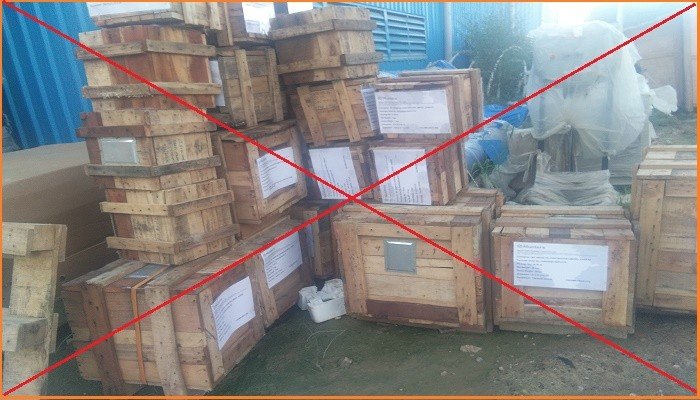Neat and orderly stacking or un-stacking minimize hazards and conserve space. Materials piled increase accidents and damage to materials. Planned material storage reduces time to bring raw materials into production and to remove finished products from production. The warehouse in charge should direct the proper stacking and un-stacking of materials.
Adequate ceiling clearance under the sprinklers, side clearance to keep free and clear the electrical panel boxes, switches, and other controls and unobstructed access (passageways) to fire hoses and extinguishers must be maintained. All the passageway and emergency exit should be kept clear. Codes on the installation of sprinkler systems should be referred for clearance between the storage and the sprinkler heads.
Loading and unloading workplace and aisles must be kept clear i.e. no material should be stocked there. Aisle width must be allowed for the turning radius of any power truck to be used. These areas must be marked or identification sign with lines.
Racks, stands, shelves, platforms, and bins should be provided to facilitate storage and reduce hazards. Height indicating line should be painted on the wall to show the maximum limit of stacking. This helps must keep the floor load within limits and sprinkler heads in the clear.
High rack (bay) storage requires unique specially designed and high lift handling the equipment. Up to 30feet (9 meters) height manually operated and for more height computer-controlled equipment are available. Audible and visual warning on moving equipment is necessary.
Toxic materials do not stack with flammable materials. Volatile material must be kept in a cool shed/place. Boxed carboys should not be stacked higher than 3 tiers and those of strong oxidizing materials, not more than 2 tiers. Incompatibility should also be checked. Proper and sufficient firefighter arrangement should be provided in and around the store.
Lifting the hoist cage should have a safe lift way. It must be enclosed that material cannot fall on workers. Landing platforms must have safe guard rails with toe guards to prevent material to fall from opening.
If two overhead traveling crane (EOT CRANE) are operated at the same height and on the same rails, limit switches, buffers, and alarms must be provided to maintain their safe inter distance and Driver’s cabins should face each other.
Paper or cloth rolls, barrels, cylinders and materials which may roll or slip must be stacked safely. Begs and boxes must be kept cross-tied and not overhang. Containers must be well marked with the content to avoid the mistake in their identification.
Material stacking not allowed near electrical panel up to how much distance?
For any flat roof:
- The vertical clearance of 2.5 meters from the highest point.
- Horizontal clearance of 1.2 meters.
Proper ladders, platform and inters tacking containers should be used.
Floor and Lay-out Conditions
- Floors: Depending upon the load and type of operations, the conditions of the floor such as (a) Cleanliness (b) Absorptive qualities (c) Marking (d) Color (e) Non-sparking of static disseminating properties and (f) Durability will give a great effect on material handling. The floor used for stacking should be of sound construction, well maintained, leveled and facilitating drainage. The ground should withstand all weather conditions for the load to be imposed. Stacks should not be built close to railway tracks or in the vicinity of vibration or possibility of fire.
- Walls: Generally walls are not retaining walls. Therefore load should not be stacked against a wall or leaning to the wall. A clearance of 18″ from wall facilitates inspection of stacks and avoids stacks touching the walls.
- Construction of Stacks: Height base ratio, size, shape, bulk, weight, type, rigidity, and fragility of materials and availability of space influence the size of stacks. Normally height should not exceed three times the narrower width. Bonding articles in the stack is useful for stability. Interlocking provides natural bounding. Artificial bonding uses materials like battens, canvas sheets, etc. between the tires. Stacking should not obstruct fire alarm boxes, sprinklers, controls, fire extinguishers, first-aid boxes, switches, fuses, lights, etc. Exits and aisles must be clear. Clearance below sprinkler heads should be more than 2 feet. It should be large enough if the material being stored is inflammable. Aisles having one-way traffic should be more than 3 feet wider than the widest vehicle when loaded. If the material is to be handled from aisles, turning radius of the power truck should also be considered. Marking a line on the wall to indicate the maximum height of stacking keeps the floor load within limit the sprinkler heads with clearance.
- Lighting: Inadequate light is a factor behind many slips, falls, and injuries. There are various types of light fittings available and these should be selected and used for specific work or areas. The required levels of illumination for different operations are given. All stores, godowns, yards, workrooms, and places of material handling should be properly illuminated.
- Ramps: Ramp gradient should not exceed 1 in 10. It should not be slippery, uneven or broken. It should have sufficient width.
- Obstructions: Pipes, conduits, drains, valves, fire apparatus, etc., are necessary parts of plant structures, yet they often cause hazards. In planning the plant, such parts should be so placed that they may cause minimum interference with persons or materials.
- Ladders: Do not climb on stock-piles. Use ladders. Fixed ladders are preferable. If the height exceeds 2 meters provide railing and hand-tools pocket for the ladders. Portable ladders should have the non-slip base or its bottom should be held, tied or securely anchored to prevent slipping.
- Bridge plates: Bridge plates should be of adequate strength and they should always be properly anchored.






